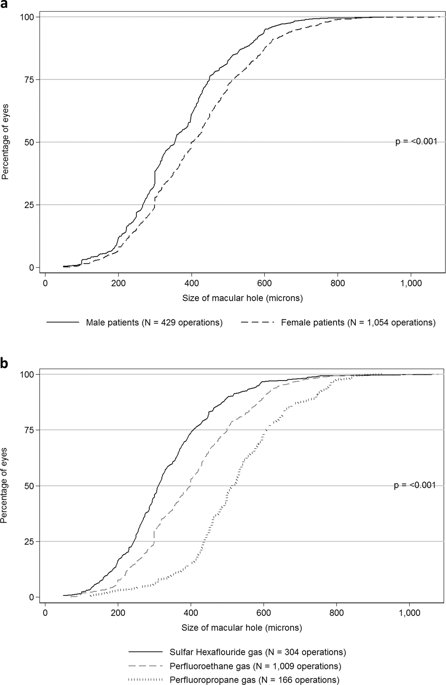Our official English website, www.x-mol.net, welcomes your
feedback! (Note: you will need to create a separate account there.)
Factors affecting anatomical and visual outcome after macular hole surgery: findings from a large prospective UK cohort
Eye ( IF 2.8 ) Pub Date : 2020-03-30 , DOI: 10.1038/s41433-020-0844-x D H Steel 1, 2 , P H J Donachie 3 , G W Aylward 4 , D A Laidlaw 5 , T H Williamson 5 , D Yorston 6 ,
Eye ( IF 2.8 ) Pub Date : 2020-03-30 , DOI: 10.1038/s41433-020-0844-x D H Steel 1, 2 , P H J Donachie 3 , G W Aylward 4 , D A Laidlaw 5 , T H Williamson 5 , D Yorston 6 ,
Affiliation

|
Objectives To reassess the definition of a large macular hole, factors predicting hole closure and post-surgery visual recovery. Design Database study of 1483 primary macular hole operations. Eligible operations were primary MH operations treated with a vitrectomy and a gas or air tamponade. Excluded were eyes with a history of retinal detachment, high myopia, previous vitrectomy or trauma. Results A higher proportion of operations were performed in eyes from females (71.1%) who were ‘on average’ younger ( p < 0.001), with slightly larger holes ( p < 0.001) than male patients. Sulfur hexafluoride gas was generally used for smaller holes ( p < 0.001). From 1253 operations with a known surgical outcome, successful hole closure was achieved in 1199 (96%) and influenced by smaller holes and complete ILM peeling ( p < 0.001), but not post-surgery positioning ( p = 0.072). A minimum linear diameter of ~500 μm marked the threshold where the success rate started to decline. From the 1056 successfully closed operations eligible for visual outcome analysis, visual success (defined as visual acuity of 0.30 or better logMAR) was achieved in 488 (46.2%) eyes. At the multivariate level, the factors predicting visual success were better pre-operative VA, smaller hole size, shorter duration of symptoms and the absence of AMD. Conclusions Females undergoing primary macular hole surgery tend to be younger and have larger holes than male patients. The definition of a large hole should be changed to around 500 μm, and patients should be operated on early to help achieve a good post-operative VA.
中文翻译:

影响黄斑裂孔手术后解剖和视觉结果的因素:来自大型前瞻性英国队列的研究结果
目的 重新评估大黄斑裂孔的定义、预测裂孔闭合和术后视力恢复的因素。1483 例原发性黄斑裂孔手术的设计数据库研究。符合条件的手术是用玻璃体切除术和气体或空气填塞治疗的主要 MH 手术。排除有视网膜脱离、高度近视、既往玻璃体切除术或外伤史的眼睛。结果 在女性眼中进行手术的比例更高 (71.1%),她们比男性患者“平均”年轻 (p < 0.001),眼孔稍大 (p < 0.001)。六氟化硫气体通常用于较小的孔 (p < 0.001)。在已知手术结果的 1253 例手术中,1199 例 (96%) 成功闭合孔,并受到较小孔和完全 ILM 剥离的影响 (p < 0.001),但不是术后定位(p = 0.072)。~500 μm 的最小线性直径标志着成功率开始下降的阈值。从符合视觉结果分析条件的 1056 例成功闭合手术中,488 只 (46.2%) 眼实现了视觉成功(定义为视力为 0.30 或更好 logMAR)。在多变量水平上,预测视觉成功的因素是术前 VA 更好、孔径更小、症状持续时间更短以及没有 AMD。结论 接受原发性黄斑裂孔手术的女性比男性患者更年轻且孔洞更大。大孔的定义应改为500μm左右,患者应尽早手术,以帮助获得良好的术后VA。~500 μm 的最小线性直径标志着成功率开始下降的阈值。从符合视觉结果分析条件的 1056 例成功闭合手术中,488 只 (46.2%) 眼实现了视觉成功(定义为视力为 0.30 或更好 logMAR)。在多变量水平上,预测视觉成功的因素是术前 VA 更好、孔径更小、症状持续时间更短以及没有 AMD。结论 接受原发性黄斑裂孔手术的女性比男性患者更年轻且孔洞更大。大孔的定义应改为500μm左右,患者应尽早手术,以帮助获得良好的术后VA。~500 μm 的最小线性直径标志着成功率开始下降的阈值。从符合视觉结果分析条件的 1056 例成功闭合手术中,488 只 (46.2%) 眼实现了视觉成功(定义为视力为 0.30 或更好 logMAR)。在多变量水平上,预测视觉成功的因素是术前 VA 更好、孔径更小、症状持续时间更短以及没有 AMD。结论 接受原发性黄斑裂孔手术的女性比男性患者更年轻且孔洞更大。大孔的定义应改为500μm左右,患者应尽早手术,以帮助获得良好的术后VA。488 (46.2%) 只眼睛实现了视觉成功(定义为视力为 0.30 或更好的 logMAR)。在多变量水平上,预测视觉成功的因素是术前 VA 更好、孔径更小、症状持续时间更短以及没有 AMD。结论 接受原发性黄斑裂孔手术的女性比男性患者更年轻且孔洞更大。大孔的定义应改为500μm左右,患者应尽早手术,以帮助获得良好的术后VA。488 (46.2%) 只眼睛实现了视觉成功(定义为视力为 0.30 或更好的 logMAR)。在多变量水平上,预测视觉成功的因素是术前 VA 更好、孔径更小、症状持续时间更短以及没有 AMD。结论 接受原发性黄斑裂孔手术的女性比男性患者更年轻且孔洞更大。大孔的定义应改为500μm左右,患者应尽早手术,以帮助获得良好的术后VA。结论 接受原发性黄斑裂孔手术的女性比男性患者更年轻且孔洞更大。大孔的定义应改为500μm左右,患者应尽早手术,以帮助获得良好的术后VA。结论 接受原发性黄斑裂孔手术的女性比男性患者更年轻且孔洞更大。大孔的定义应改为500μm左右,患者应尽早手术,以帮助获得良好的术后VA。
更新日期:2020-03-30
中文翻译:

影响黄斑裂孔手术后解剖和视觉结果的因素:来自大型前瞻性英国队列的研究结果
目的 重新评估大黄斑裂孔的定义、预测裂孔闭合和术后视力恢复的因素。1483 例原发性黄斑裂孔手术的设计数据库研究。符合条件的手术是用玻璃体切除术和气体或空气填塞治疗的主要 MH 手术。排除有视网膜脱离、高度近视、既往玻璃体切除术或外伤史的眼睛。结果 在女性眼中进行手术的比例更高 (71.1%),她们比男性患者“平均”年轻 (p < 0.001),眼孔稍大 (p < 0.001)。六氟化硫气体通常用于较小的孔 (p < 0.001)。在已知手术结果的 1253 例手术中,1199 例 (96%) 成功闭合孔,并受到较小孔和完全 ILM 剥离的影响 (p < 0.001),但不是术后定位(p = 0.072)。~500 μm 的最小线性直径标志着成功率开始下降的阈值。从符合视觉结果分析条件的 1056 例成功闭合手术中,488 只 (46.2%) 眼实现了视觉成功(定义为视力为 0.30 或更好 logMAR)。在多变量水平上,预测视觉成功的因素是术前 VA 更好、孔径更小、症状持续时间更短以及没有 AMD。结论 接受原发性黄斑裂孔手术的女性比男性患者更年轻且孔洞更大。大孔的定义应改为500μm左右,患者应尽早手术,以帮助获得良好的术后VA。~500 μm 的最小线性直径标志着成功率开始下降的阈值。从符合视觉结果分析条件的 1056 例成功闭合手术中,488 只 (46.2%) 眼实现了视觉成功(定义为视力为 0.30 或更好 logMAR)。在多变量水平上,预测视觉成功的因素是术前 VA 更好、孔径更小、症状持续时间更短以及没有 AMD。结论 接受原发性黄斑裂孔手术的女性比男性患者更年轻且孔洞更大。大孔的定义应改为500μm左右,患者应尽早手术,以帮助获得良好的术后VA。~500 μm 的最小线性直径标志着成功率开始下降的阈值。从符合视觉结果分析条件的 1056 例成功闭合手术中,488 只 (46.2%) 眼实现了视觉成功(定义为视力为 0.30 或更好 logMAR)。在多变量水平上,预测视觉成功的因素是术前 VA 更好、孔径更小、症状持续时间更短以及没有 AMD。结论 接受原发性黄斑裂孔手术的女性比男性患者更年轻且孔洞更大。大孔的定义应改为500μm左右,患者应尽早手术,以帮助获得良好的术后VA。488 (46.2%) 只眼睛实现了视觉成功(定义为视力为 0.30 或更好的 logMAR)。在多变量水平上,预测视觉成功的因素是术前 VA 更好、孔径更小、症状持续时间更短以及没有 AMD。结论 接受原发性黄斑裂孔手术的女性比男性患者更年轻且孔洞更大。大孔的定义应改为500μm左右,患者应尽早手术,以帮助获得良好的术后VA。488 (46.2%) 只眼睛实现了视觉成功(定义为视力为 0.30 或更好的 logMAR)。在多变量水平上,预测视觉成功的因素是术前 VA 更好、孔径更小、症状持续时间更短以及没有 AMD。结论 接受原发性黄斑裂孔手术的女性比男性患者更年轻且孔洞更大。大孔的定义应改为500μm左右,患者应尽早手术,以帮助获得良好的术后VA。结论 接受原发性黄斑裂孔手术的女性比男性患者更年轻且孔洞更大。大孔的定义应改为500μm左右,患者应尽早手术,以帮助获得良好的术后VA。结论 接受原发性黄斑裂孔手术的女性比男性患者更年轻且孔洞更大。大孔的定义应改为500μm左右,患者应尽早手术,以帮助获得良好的术后VA。











































 京公网安备 11010802027423号
京公网安备 11010802027423号